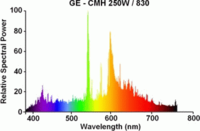
Photo from wikipedia
The presence and composition of W-Os alloys have been found to significantly affect the thermionic emission properties of Os-coated tungsten dispenser cathodes. However, the comprehensive understanding of structure–property relationships needed… Click to show full abstract
The presence and composition of W-Os alloys have been found to significantly affect the thermionic emission properties of Os-coated tungsten dispenser cathodes. However, the comprehensive understanding of structure–property relationships needed to design improved tungsten cathodes with larger thermionic emission is still lacking. In this study, composition–structure–property relationships governing thermionic emission from W-Os alloys were investigated using quantum mechanical calculations. Low-energy W-Os atomic configurations at various compositions were determined from first-principles calculations based on density functional theory in combination with cluster expansion calculations. Electronic properties were investigated in terms of the electron density of states. The relative position of the Fermi level with respect to peaks and pseudogaps in the density of states for different W-Os structures can be used to explain, at least in part, observed variations in thermionic emission from Os-coated tungsten dispenser cathodes.The presence and composition of W-Os alloys have been found to significantly affect the thermionic emission properties of Os-coated tungsten dispenser cathodes. However, the comprehensive understanding of structure–property relationships needed to design improved tungsten cathodes with larger thermionic emission is still lacking. In this study, composition–structure–property relationships governing thermionic emission from W-Os alloys were investigated using quantum mechanical calculations. Low-energy W-Os atomic configurations at various compositions were determined from first-principles calculations based on density functional theory in combination with cluster expansion calculations. Electronic properties were investigated in terms of the electron density of states. The relative position of the Fermi level with respect to peaks and pseudogaps in the density of states for different W-Os structures can be used to explain, at least in part, observed variations in thermionic emission from Os-coated tungste...
Journal Title: Journal of Vacuum Science and Technology
Year Published: 2017
Link to full text (if available)
Share on Social Media: Sign Up to like & get
recommendations!